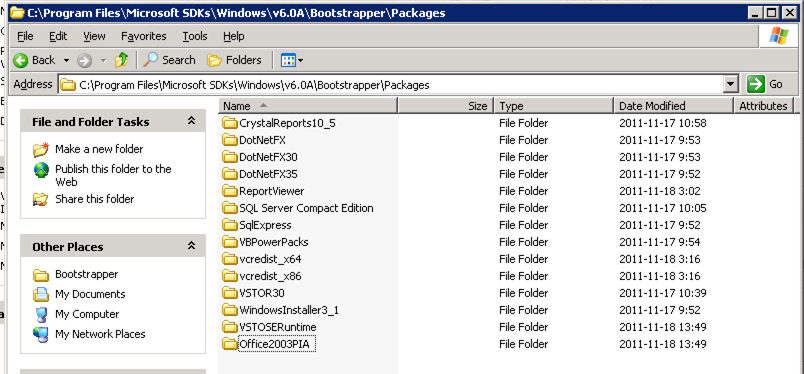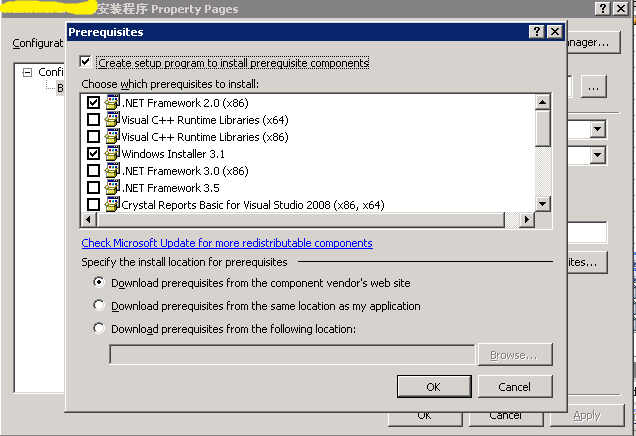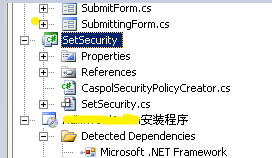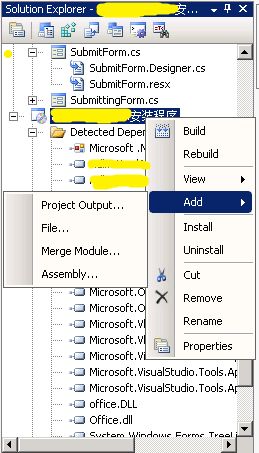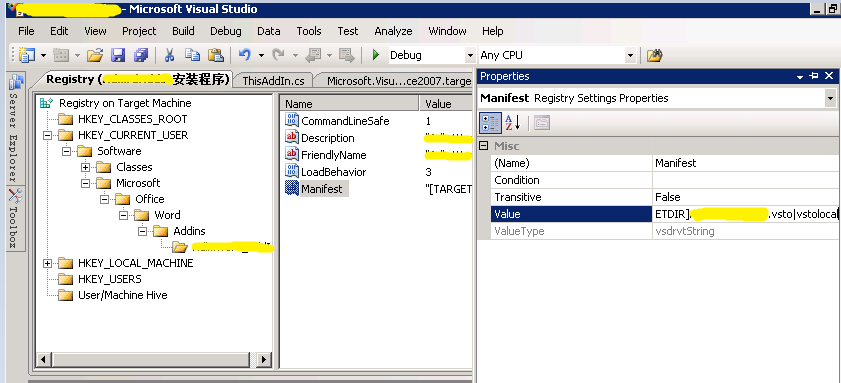Office 2003 VSTO add-in can run in debug mode but cannot load after installation
[Author: Fish Ge, Office/Project Support Team, Microsoft Asia Pacific Global Support Center]
[???: https://blogs.technet.com/b/officeasia/archive/2011/12/14/office2003-vsto.aspx]
Hope this article is helpful to VSTO and Office add-in developers.
Problem Description
You develop Office 2003 VSTO add-in using Visual Studio 2008. On developer machine you can run the add-in from Visual Studio in debug mode, however when the add-in is installed, it cannot load or the custom menus in add-in doesn't respond.
Solution
To troubleshoot add-in loading issue, we can follow https://msdn.microsoft.com/en-us/library/ms269003(v=VS.90).aspx to add environment variable VSTO_SUPPRESSDISPLAYALERTS=0 and VSTO_LOGALERTS=1. By this way, everytime the add-in fails to load there will be error message.
Then let's see what prerequisites are needed for running Office 2003 VSTO add-in (http://msdn.microsoft.com/en-us/library/bb332051(office.12).aspx):
Table 1. Summary of bootstrapper packages that accompany the article
Bootstrapper package |
Dependent packages |
Other conditions |
VSTO 2005 SE runtime |
The .NET Framework 2.0 |
|
Visual Studio Tools for Office Language Pack |
VSTO 2005 SE runtime |
|
Primary interop assemblies redistributable package for the 2003 release of Office |
.NET Framework 2.0 |
Installs all primary interop assemblies if Office 2003 is installed. |
Primary interop assemblies redistributable package for the 2007 release of Office |
.NET Framework 2.0 |
Installs all primary interop assemblies if the 2007 release of Office is installed. |
When we develop Office 2003 add-in in Visual Studio 2005, these prerequisites can be checked on in add-in's installation project properties. However Visual Studio 2008 only include prerequisites for Office 2007 add-ins, such as Visual Studio Tools for Office system 3.0 Runtime and Primary Interop Asseblies 2007. Lack of prerequisites for Office 2003 add-in will result in failure of loading.
Below are complete steps to deploy Office 2003 using Visual Studio 2008:
1. Download Microsoft Visual Studio 2005 Tools for Office SE Resources Visual Studio 2005 Tools for Office Second Edition Sample: Deploying Office Solutions Using Windows Installer Version 3
2. Visit “C:\Program Files\Microsoft Visual Studio 2005 Tools for Office SE Resources\VSTO2005SE Windows Installer Sample Version 3\packages”, copy VSTOSERuntime?Office2003PIA folder to”C:\Program Files\Microsoft SDKs\Windows\v6.0A\Bootstrapper\Packages”
3. Download Download VSTO 2005 SE Runtime https://www.microsoft.com/download/en/details.aspx?displaylang=en&id=2392, and copy to “C:\Program Files\Microsoft SDKs\Windows\v6.0A\Bootstrapper\Packages\VSTOSERuntime”
4. Start Visual Studio 2008 command line, navigate to“C:\Program Files\Microsoft Visual Studio 2005 Tools for Office SE Resources\VSTO2005SE Windows Installer Sample Version 3\Projects\Checks”
5. Run the following command:
cl.exe /Oxs /MT /GS ComponentCheck.cpp advapi32.lib
6. When it is completed, we will see ComponentCheck.exe and ComponentCheck.obj
7. Copy ComponentCheck.exe to “C:\Program Files\Microsoft SDKs\Windows\v6.0A\Bootstrapper\Packages\VSTOSERuntime”?C:\Program Files\Microsoft SDKs\Windows\v6.0A\Bootstrapper\Packages\Office2003PIA”
8. Right click setup project in Visual Studio 2008, and check on below in Prerequisites:
- .NET Framework 2.0
- Windows Installer 3.1
- Microsoft Office 2003 Primary Interop Assemblies
- Microsoft Visual Studio 2005 Tools for Office Second Edition runtime
9. Follow https://msdn.microsoft.com/en-us/library/bb332052(v=office.12).aspx#officevstowindowsinstallerwalkthrough_creatinginstallerpackagestodeploysolutions, start from sectoin Adding a Custom Action to Grant Trust to the Assembly till To add a launch condition for the VSTO 2005 SE runtime
1) After add-in is installed, we need to use CASPOL.EXE (shipped with .NET Framework 2.0) to add trust level to all add-in files, otherwise the custom menu in the add-in may not respond. Load project ”C:\Program Files\Microsoft Visual Studio 2005 Tools for Office SE Resources\VSTO2005SE Windows Installer Sample Version 3\projects\SetSecurity”
Modify CaspolSecurityPolicyCreator.cs from SetSecurity project:
To simplify the steps, replace original code by below part (the modified part is highlighted):
// Add the solution code group. Grant no permission at this level.
string arguments = policyLevel + " -q -ag " + parentCodeGroup + " -url \"" + solutionInstallationUrl + "\" FullTrust -n \"" + solutionCodeGroupName + "\" -d \"" + solutionCodeGroupDescription + "\"";
try
{
RunCaspolCommand(frameworkFolder, arguments);
}
catch (Exception ex)
{
string error = String.Format("Cannot create the security code group '{0}'.", solutionCodeGroupName);
throw new Exception(error, ex);
}
//// Add the assembly code group. Grant FullTrust permissions to the main assembly.
//try
//{
// // Use the assembly strong name as the membership condition.
// // Ensure that the assembly is strong-named to give it full trust.
// AssemblyName assemblyName = Assembly.LoadFile(assemblyPath).GetName();
// arguments = policyLevel + " -q -ag \"" + solutionCodeGroupName + "\" -strong -file \"" + assemblyPath + "\" \"" + assemblyName.Name + "\" \"" + assemblyName.Version.ToString(4) + "\" FullTrust -n \"" + assemblyCodeGroupName + "\" -d \"" + assemblyCodeGroupDescription + "\"";
// RunCaspolCommand(frameworkFolder, arguments);
//}
//catch (Exception ex)
//{
// try
// {
// // Clean the solutionCodeGroupName.
// RemoveSecurityPolicy(machinePolicyLevel, solutionCodeGroupName);
// }
// catch { }
// string error = String.Format("Cannot create the security code group '{0}'.", assemblyCodeGroupName);
// throw new Exception(error, ex);
//}
In Custom Action, add Primary output from SetSecurity
3) A sample of CustomActionData for Install is:
/assemblyName="<add-in name>.dll" /targetDir="[TARGETDIR]\" /solutionCodeGroupName="<corp name>.<add-in name>.dll" /solutionCodeGroupDescription="Code group for <add-in name>" /assemblyCodeGroupName="<add-in name>" /assemblyCodeGroupDescription="Code group for <add-in name>" /allUsers=[ALLUSERS]
4) A sample of CustomActionData for Uninstall and Rollback is:
/solutionCodeGroupName="<corp name>.<add-in name>.dll"
5) Add Launch Conditions
10. Recompile the add-in project adn installation project, then install the add-in to target machine. This add-in will load in both Office 2003 and 2007.
Follow-up Issues
If an Office 2003 add-in project develped in Visual Studio 2008 is opened in Visual Studio 2008 with Office 2007 installed, there will be upgrade notification. After upgrade, add-in reference against Office 2003 VSTO runtime and PIA will be changed to Office 2007 (version 11 to version 12). If we just compile the installation project and install the add-in, the add-in will not load.
The cause of the issue is that Office 2007 VSTO add-in will have Manifest in registry key like [TARGETDIR]<add-in name>.vsto|vstolocal, however the Office 2003 add-in will have Manifest in registry key like [TARGETDIR]<add-in name>.dll.manifest. There're two solutions (not backward compatible):
1. Create a new Office 2007 add-in project in Visual Studio 2008, and copy the add-in code from Office 2003 add-in project to the new one.
2. Add <add-in name>.dll.manifest and <add-in name>.vsto into add-in installatin project. We can right click installation project->Add->File, and include these two files:
Then right click installation project->View->Registry, find Manifest key, change [TARGETDIR]<add-in name>.dll.manifest to [TARGETDIR]<add-in name>.vsto|vstolocal
Rebuild the project and now the add-in can load in Office 2007. The drawback is that the add-in cannot load in Office 2003 anymore.
Similar issue is posted here:
https://social.msdn.microsoft.com/Forums/en-US/vsto/thread/75dbff40-181b-434f-87fe-7fa7e21a5828
References
Deploying Visual Studio 2005 Tools for the Office System SE Solutions Using Windows Installer (Part 1 of 2)
https://msdn.microsoft.com/en-us/library/bb332051(office.12).aspx
Deploying Visual Studio 2005 Tools for the Office System SE Solutions Using Windows Installer: Walkthroughs (Part 2 of 2)
https://msdn.microsoft.com/en-us/library/bb332052(v=office.12).aspx
Troubleshooting COM Add-In load failures
https://blogs.msdn.com/b/vsod/archive/2008/04/22/troubleshooting-com-add-in-load-failures.aspx
VSOD (CSS) team blog:
Visual Studio Office Development (VSOD) Support Team
https://blogs.msdn.com/b/vsod/
VSTO (Product team) team blog:
